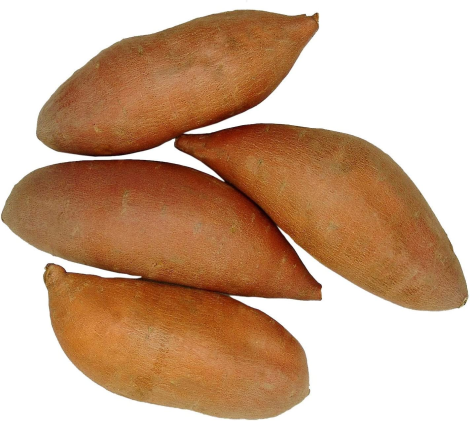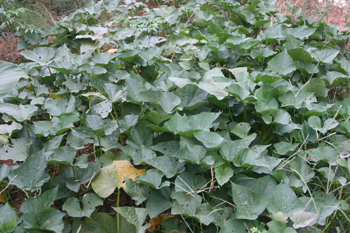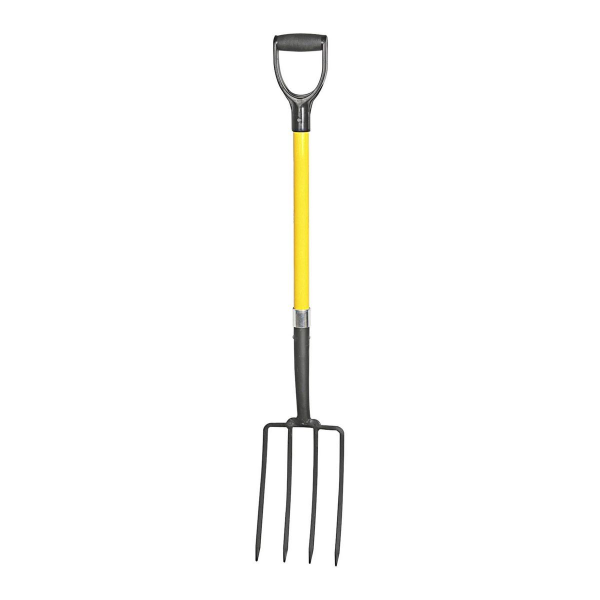We’re toying with the idea of a sweet potato patch this year. Therefore we need to do some research on how to grow sweet potatoes. This interesting food lies at the intersection of several things we’re interested in. It’s food, it’s a chance to do human scale living, and it’s part of the local culture. Also we have a few acres of unproductive land, and we like it to be productive.
Sweet potatoes grow readily in backyard gardens in Georgia. They’re planted from slips, 3-4 inches deep, somewhere between 1 and 3 feet apart. The soil temperature needs to be 70 degrees F, which in this area happens in early to mid-May. The plants require an inch of water per week, so average natural rainfall is plenty. They are harvested by digging, 90-110 days after planting. When stored in a cool, dry place, they keep for a long time.

Why would you want to grow Sweet Potatoes?
Well we suppose there are several reasons. If the lunatic fringe is right, we may need to find alternate sources of food. If the lunatic fringe is wrong, we did it because we could.
A few of these happen to be grown in one of those square states where they grow everything else. Here is a fun video.
The current price of sweet potatoes, at the local Wally Mart, is 59 cents per pound. This being the case, it is questionably economically worth it, if you can go to the store and buy them. According to the Grower Experts, the big ones weigh 8 ounces, so we’re really only talking about 30 cents apiece.
But this is a prime example of a situation where you are dependent on diesel fuel and wally mart for your supply of sweet potatoes, and we need to experiment with ways to work around that problem, just in case we need to.
According to this article, 85% of sweet potatoes are grown in California or North Carolina, and we would prefer not to walk to either place.
How To Grow Sweet Potatoes in Georgia: Space
Well, I suppose our study of how to grow sweet potatoes in Georgia depends on some assumptions. We need a high level survival strategy. Assuming for the moment that we are doing this to prove to the Doomsday Preppers that we are cool, we need a little information.
Let’s say hypothetically we want to grow a comfortable supply of sweet potatoes. If we have two adults, we’ll define “comfortable” as three meals per week, or a total of 300 sweet potato meals. Do we really want to eat sweet potatoes three times a week? No not really, but it is quite true that if we get sick of them, it would be easy to feed them to a converter, and convert them into something else, such as eggs.
According to the Grower Experts, who we have linked below, the big ones weigh 8 ounces.
Sweet Potatoes Per Plant
According to the link below, in Buffalo, you can potentially get 8-10 sweet potatoes per plant.
The Square Foot Gardener doesn’t think you can get more than 3-5 per plant, but they’re only planting them in a square foot.
So we’re going to have to figure somewhere in the middle of this, since we are not in a place with glacial till, and conservatively figure about four.
Planting Distance
The preferred method of sweet potato planting is the “slip”, which the UGA Extension Service thinks should be planted three feet apart.
So we are going to have to do math now.
| Number of Plants | Square Footage Needed | Yield @4 per plant | Yield @8 per plant |
| 1 | 9 | 4 | 8 |
| 10 | 90 | 40 | 80 |
| 25 | 225 | 100 | 200 |
| 50 | 450 | 200 | 400 |
Thought Question:
Since we think we need around 300-ish sweet potatoes, for a year’s supply, do we really have somewhere in the neighborhood of 450 square feet of space? That would be 20X22.5.
Well, as it turns out, we do. We have lots of space. We also found a rototiller the other day, and the preliminary ground softening would not even be that big of a problem. So at this level, the project is doable if we were sufficiently determined. Second question: Do we have enough fence to keep the deer from gnawing on the plants? Actually, we have an extra roll of fence out here, and we do indeed have the 85 linear feet of fence we would need for that.
We also have a limited supply of fenceposts. Part of our unmanicured abundance is to keep stuff around longer than we should.
Planting Method
The Extension Service did not give us the detail on exactly how deep to plant the slips. Maybe they assume that we will not be stupid and bury the whole thing. The Southern Exposure Seed Exchange seems to think that planting them 3-4 inches deep will do the job, leaving two leaves above ground for the deer to eat.
So, that’s 50 big scoops of one of our big shovels. If we rototilled it first, this would be a good morning’s work.
Planting From Seed
We actually bought a lot of sweet potato seeds from someone in some strange land the other day, and there is very limited information on how, or even whether to plant from seed.
Here is a comical video on this topic:
If we were to commit to this, we’d focus mainly on the slips, although there is a clue. According to the UGA extension service, if you over-fertilize these guys, they’ll go to tops and not give you any tubers, so an argument can be made that this guy who failed at sweet potatoes from seeds was too geeky, and had too good of soil.
Cost of Slips
Well, as it turns out, this varies by variety. There’s a link down below from Johnny’s Seeds who will sell us 50 of these things for $46, but they’re organic. Annie’s Heirloom Seeds will sell us that many for $36.
Oddly, at least this time of year going into Redneck Winter, the cost of slips on Amazon is actually greater than that, but as we found out, we don’t want to order them yet because it’s not planting time. The price might be different.
By the way, you can get 8 pounds of actual sweet potatoes via Amazon for $21, which is a rate of $2.60 per pound. Would we have the nerve to go to Wally, buy sweet potatoes for $.59 per pound and sell them for $2.60? I don’t know why we didn’t think of it.
Anyway, that looks like the outlay unless one of the local places have them cheaper.
Math Check
Oh, yeah. At a rate of 72 cents per plant, we’d better get at least two pounds of yield from each plant, otherwise we are being silly. I guess that’s the risk of being a farmer.

How to Grow Sweet Potatoes in Georgia: Soil Amendments and Planting Schedule
The UGA people seem to think we need to add a lot of soil amendments and chemical fertilizers to these things, but we would like to avoid it for two reasons: They cost money, and it is questionably worth it economically anyway. Also, we’d prefer to keep that stuff out of the food supply. Actually there’s a third reason, which is that we have plenty of free fertilizer at our place as it is, since we have converters around converting grass into eggs and fertilizer all the time.
The planting: Well, we’re in Zone 8B, and the professionals think we should wait until the soil temperature reaches 70F, which is in early May sometime, but we suppose that depends on how much sunshine the spot gets. The suggested spot is supposed to get 8 hours of sun per day, and we have a couple of sunny spots where we believe that can happen.
If we really had our act together, we’d plant zucchini between the rows, which would be done by the time the sweet potato vines started to spread.
Watering and Harvesting Sweet Potatoes
Water: The Extension Service says we need about one inch of water per week, and most years, this is not a problem. Some years, like the year we tried to build the Guest House, we had more rain than Seattle. Average rainfall here in June and July is about one inch per week, according to the link below, so this is good. Water, free from the sky. California? nah. They’re out of luck. PS: For that matter, that’s another reason to try to grow your own.
You’re supposed to harvest these lovely tubers somewhere around 100 days after they are planted, when the tops dry out. If we really had our act together we’d release the converters into our enclosure at about the 90 day mark and have them eat the tops. You’re not supposed to water them for the last couple of weeks, because if you do, they’ll split. I suppose that would be around Labor Day, and that’s not a problem.
Harvesting: Seems like this is done by something called a “Diggin’ fork.” I think we have one around the place already but the Harbor Freight will sell us one for $25 if we really go through with this. We’d love to teach the converters to dig them for us, while we sit on the porch drinking tea, but that is unlikely.
Storage
Once you dig ’em up, you have to lay them out in the sun for a few days to dry out a bit.
According to the North Carolina Sweet Potato people, you’re supposed to keep these guys in a cool, dry place away from heat sources.
We can probably find a place like that somewhere. i imagine someone will sell us a few potato sacks, which will give some ventilation.

How to Grow Sweet Potatoes in Georgia
So here you have it. A 450 square foot area, a $36 dollar investment in slips, and a sore back can get us enough potatoes to feed a couple of people three times a week for a year. Would we plant 300 pounds of potatoes for $36 and then sell them for $2.60 per pound on Amazon? That is a possibility, but it would be a hard way to earn $840.
Would we barter some of our sweet potatoes, if we are lucky enough to get them, for something of value? We might do that. A starving fellow, walking his cow to town to be sold might very well swap us if we told him they were magic. Children’s stories have been written with less material than that.
Do we want to do this? The firm commitment has not been made yet. But, it is an idea.
Offer to City Slickers
Here is another idea. Since we are all about experiencing the rural lifestyle, we will extend this offer to you, someone who wants to escape to the country.
We will let you come out here, dig holes in the ground and plant some sweet potatoes, and enjoy the pleasure of harvesting them. We will even provide a diggin’ fork for the purpose.
Click the “booking options” at the bottom of the page here, and reserve your time in mid-May or maybe early September.
If you want us to teach you how to build a fence with surplus materials, that’ll probably happen in January before it gets too hot. That might happen whether we dig the holes or not.
Links and References
Sweet Potatoes Per Plant
Square Foot Gardening
Amazon
https://www.almanac.com/gardening/frostdates/GA/Athens
https://www.rssweather.com/climate/Georgia/Atlanta/
![]()
